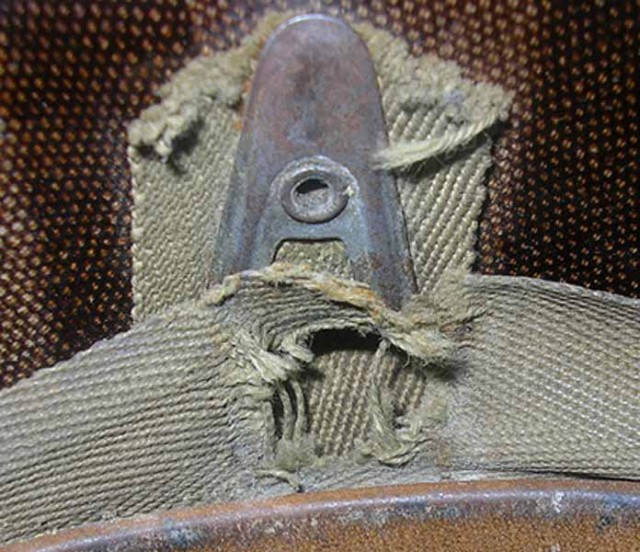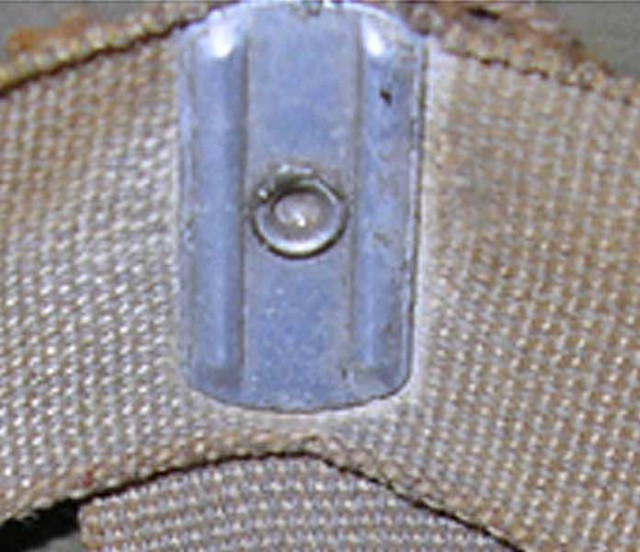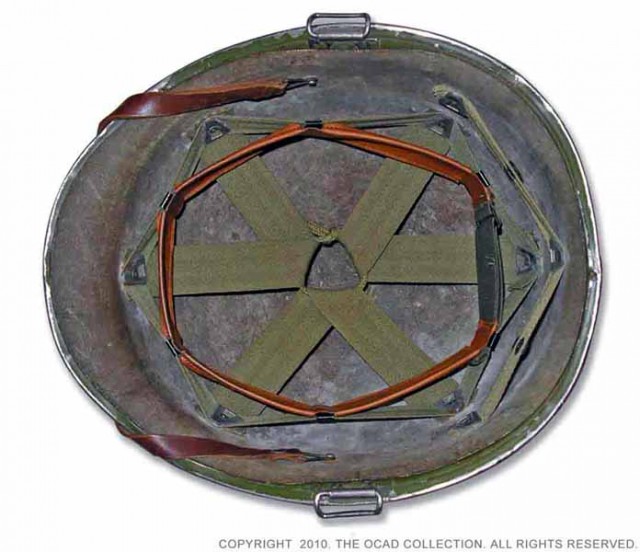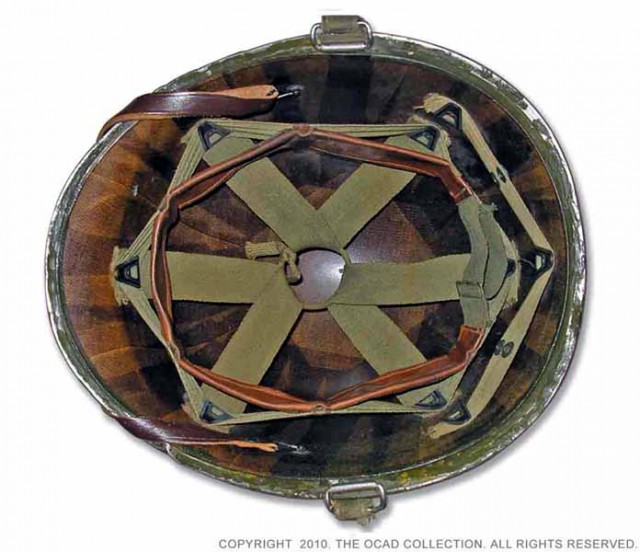The article is compliments of History Online..'
The M1 helmet was a unique and practical solution, compared to its contemporaries.
A separate lining system had many advantages. Being light weighted it could be used without the steel shell for guard or ceremonial duties, whilst the shell itself could also double up as a wash basin in the Field
An early liner made from compressed card.
The first liners were from the Hawley company. Distinctive in form and desirable to collectors, the Hawley liner mimicked the shell in form, and was made of compressed cardboard painted a light shade of khaki green in the inner. It was covered by a similar coloured cloth stretched over its outer surface and tucking under the rim into a bevel, a key characteristic of all Hawley liners.
White rayon was initially used for the webbing, attached to the liner by rectangular aluminium washers. An adjustable and removable rayon sweatband was also clipped into position using poppers, and featured a leather lined forehead section.
Later Hawley examples featured light khaki herringbone twill webbing with ‘A’ washers. An improved sweatband was now fully faced in lea and clipped onto the webbing.
Due to their fragility and susceptibility to damp and humid conditions the Hawley liner was replaced in favour of what collectors termther Low Pressure liners.


A composite showing different washers.
Low Pressure liners were made by the companies Hood and St Clair and were constructed of rubber fibre. The outer surface was painted olive drab and featured an air vent above the frontal rivet, a feature of all subsequent wartime liners. The air vent was also used to attach officer rank insignia. The interior was left unpainted. The material thickness is also notable thinner than all other liner variations. The webbing was as that used on later pattern Hawleys.

The dull finish of this liner is much different from the classic tortoiseshell look.
Similar to their cardboard cousins, the Low Pressure liner was soon also found to be inadequate for military use, with many later being refurbished as kid’s toys.
By late mid-war the High Pressure liners had generally replaced the older patterns and were manufactured by a host of companies. Such liner bodies were hard and made up of a composite fibre material, which could take some flexing but would split under increased pressure. As with all M1 liners their shape was a clone of the steel shell and fitted snugly into place. However it is not uncommon to see scuff marks or scratches, especially on the exposed rivet heads.

This liner’s tortoiseshell patterned interior has a classic look about it and is much sought after.
The outside surface of the HP liner was OD, reflecting the colour of the shell, but in some rare cases liners have been found where they were left unpainted. The inside of the body was left unpainted and has a ‘Tortoise-shell’ look.
It is not uncommon to find liners sporting regimental and or divisional crests and markings or even the outer surface painted in another colour; such as white for medics, military police (“Snow-drops”) or snow camo etc.
Chinstraps were made from brown leather and featured a green metal adjusting clip, which later changed to black. After WWII the colour of the liner’s webbing also changed
to a darker green shade.
Aside from the early examples made by Hawley, Hood and St. Clair, liners were also manufactured by Capac; Firestone; Inland; International Moulded Plastics; MSA; Seaman and Westinghouse. At the end of the war these companies resumed their peacetime role, with Capac supplying a limited number of liners for the Korean War period.
A Vietnam War period linerThe Vietnam War era liner was made from a thicker fibre that was more orange in appearance. It lacked an air vent and separate chinstrap, while the webbing arrangement was simplified. Instead of the helmet sitting low over the nape of the neck it was worn more level on the head. The M1 was finally replaced during the 1980s.
Using this guide, I looked at my "old" helmet..
I had this helmet before I joined the Army...this was my "play Army" helmet. I really don't know where I got it from but I remember having it when I was "knee high to a grasshopper" to use a "southernism".
I got the cover later on...I just had the "steel pot and liner sans cover." It looks like a variation of the "Vietnam War helmet.
This Helmet was what I was first issued when I got into country, I had this one for a week in Germany.
Looks brand new....I never wore it. I was sent back to C.I.F.(Central Issue Facility) to get more issue and they gave me this one...
This the helmet that I was issued in 1986. The cover was the "Woodland Camo" pattern at the time, I got the "Choco chip" pattern when I went to the Gulf. They never asked me for the "steel pot" that I was initially issued and I hung onto it. When I cleared C.I.F after my first tour, I turned in a "spare". When you are stuck working in C.I.F for 30 days you have opportunities...I snagged a "damaged" one while I was there and turned it in to clear C.I.F. and kept "mine". When I went to my second duty station in Germany, I took the TA-50 and kept it in a dufflebag. By this time I had purchased my own web gear and other stuff from Clothing sales and had modified it for me. When I cleared C.I.F. for return to the world in 1991, I turned in the gear I was issued and never used. I knew all the tricks that the C.I.F people used so I knew what to look for. I also had a letter that my C.O wrote for all the G.I's out-processing, about "Fair wear and Tear" and the regulations that allowed for it. This kept us from having charges against our pay or having to go to clothing sales and buy new stuff to turn in so we could clear C.I.F. He cared about the mission but he also made sure that the troops were taken care the best he could. He was an outstanding officer and we would follow him to hell and back.
This is the webbing of the helmet. it wasn't really comfortable...so many GI's would buy the circular foam padding from clothing sales to make the helmet more comfortable especially for long periods of wear.
In the U.S. military, the PASGT helmet was most commonly known by its wearers as simply the "Kevlar". The nickname has since been adopted for usage with other helmets. The PASGT helmet was also referred to by its wearers in the U.S. military as the "K-pot", similar in name to the colloquial nickname "steel pot" for the steel M1 helmet, which was in widespread U.S. military usage from the 1940s, to the 1970s, including the Vietnam War. The PASGT helmet was also, but less commonly, known by its wearers as the "Fritz" helmet for its resemblance to the Stahlhelm, which was the standard helmet used by the German military forces in the First and Second World Wars.
All GI's had something on their helmet kinda like a "lucky Talisman". I put this stripper clip guide on it when I first got in country and left it on....It is still there.
I had found a piece of camo netting during a field exercise early in my career, it was green on one side and brown on the other and I stuck it in my gear. When I would go on field exercises or alerts, I would pull out the camo piece and put it on the helmet and use the helmet band to hold it in place. . Well we got ready to go to the Gulf and they gave us the choco-chip helmet cover. No DCU's, just the helmet cover ( We didn't get the Desert Combat Uniform until the war was over, so we fought the war in BDU's. As I understand it later, the Iraqi's feared us because of the green uniform. We had faced down their trainers in Europe, we were well trained and equipped and we had won.) Well when I got the Choco-chip cover, I changed out the "Woodland Camouflage",then I pulled out my piece of camo net and stuck it on my helmet, brown side out. I know...it looked goofy but it is what I wore. I was trying to break up the round outline of my helmet. I also had some brown camo netting on the foregrip of my M16 Rifle. Strange things G.I's do in a war zone.











Everybody develops their own 'talismans', yours brought you home!
ReplyDeleteEverybody develops their own 'talismans', yours brought you home!
ReplyDelete